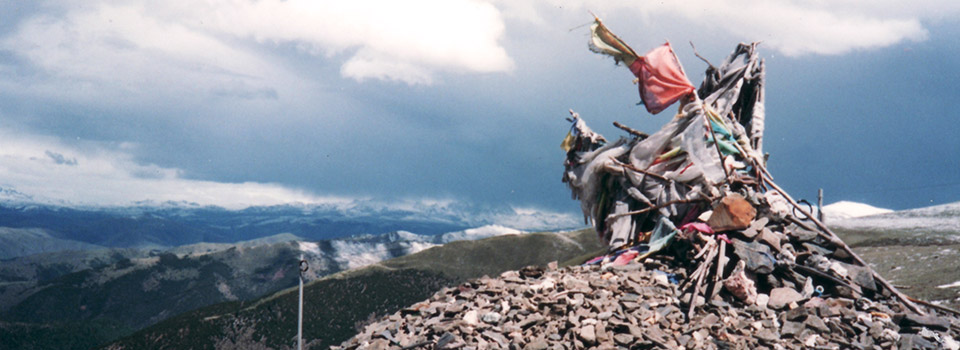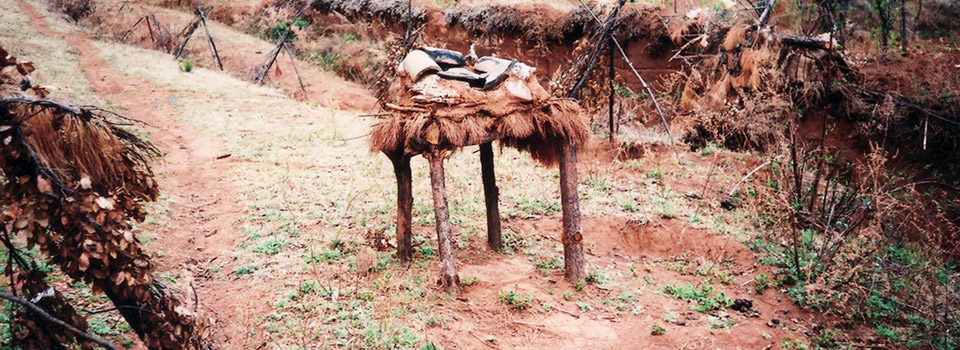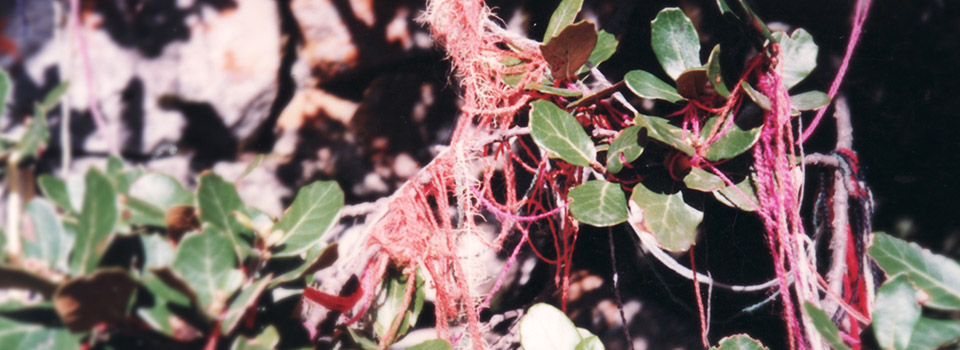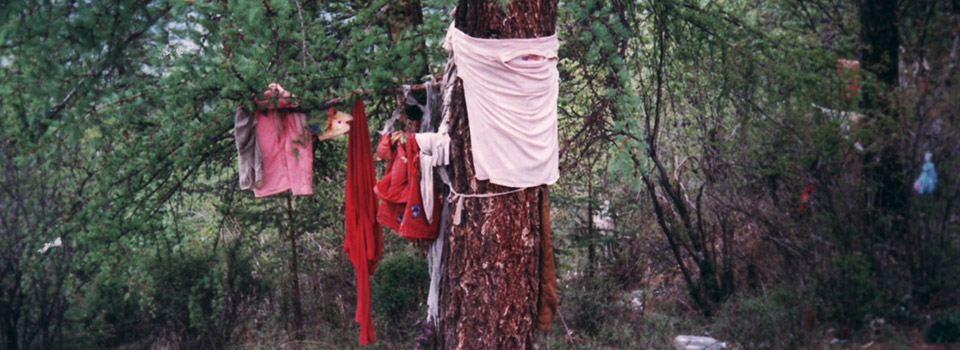Kham is one of the most distinctive biological regions on earth. It is situated between Qinghai-Tibetan plateau and the Chinese provinces of Sichuan and Yunnan, comprising part of the three regions of ‘Cultural Tibet’. The custodians of bio-cultural diversity in Kham recognise three traditions of sacred natural sites, or ritually protected enclosures. Two are Tibetan Buddhist and include mountains gnas ri and valleys sbas yul. The third tradition is characterised by pre-Buddhist animistic ‘mountain cults’ who protect ri-r enclosures which are embodied or numinised by a divinityyul-lha with human personality. The yul-lha owns the biophysical resources and the enclosure is characterised by explicit nature conservation. Such sacred natural sites can be unlogged forests, ritual cairns la btsas, various water catchments ri rgya klung amongst others.
Kham’s shamans and priests are often knowledgeable about trees, plants and animals and play an important role in environmental storytelling and topocosmic mediation. The religious paradigms that constitute indigenous life are based on respect for the sources of spiritual life, food, clothing and shelter that nature provides. This instils a sense of gratitude to the spiritual forces in creation and nature. Ritual calendars are based on natural phenomena such as migratory birds, the blooming of certain plants or the movement of the planets. There appears to be a strong tradition of natural resource care among the minority nationalities that is also enshrined in their unique languages.
Animistic and Shamanistic sacred natural sites are endangered.
Tibetan Buddhist’s sacred natural sites are threatened.
Animistic and Shamanistic Sites are endangered and Tibetan Buddhist sites are increasingly threatened as external impact such as logging and resettlement by the Han Chinese. These activities have led to climate change, erosion and snow disasters as well as declines in the diversity of flora and fauna and impacts on the survival of the indigenous cultures. Challenges to conquer include:
- Perverse economic theory centred on materialist values and the cultural elitism of western science resulting into narrowly conceived planning and policy,
- Cultural Assimilation and the sedentisation of nomads forced by a new enclosure movement (e.g. fencing off historic grazing land),
- Imposition of a development agenda which is oblivious of the inequalities in power relations,
- Conflation of "animistic" and "Tibetan Buddhist" experience of sacred place and space.
To ensure the sacred natural sites and bio-cultural diversity of Kham by establishing a "cultural mapping" augmented by the employment of "knowledge brokers".
Conservation Tools
Cultural mapping (or participatory GIS) aims to enhance bio-cultural diversity using a wide range of research techniques and tools to "map" distinct peoples' tangible and intangible cultural assets and aspirations within local landscapes. Priority should be given to mapping sealed or protected ri-rgya territories associated with yul-lha.
Knowledge brokers are required to achieve synergy between local earth-care practices and beliefs and those of the state and other stake-holders. . Knowledge brokers enhance the wellbeing of indigenous people and their bio-cultural diversity by bringing multiple worldviews and paradigms together around the problems or aspirations of their indigenous “clients”. The success of this approach is dependent on the political will of the state.
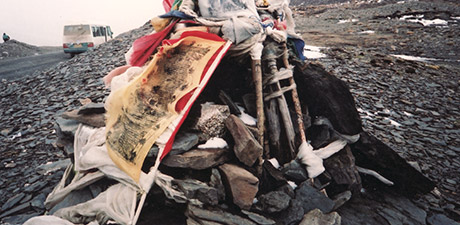 An animistic cairn la-btsas at Kuluke is typically used to honour territorial spirits yul-lha and situated within a ritually protected enclosure ri-rgya. It is covered with prayer flags depicting wind horses rlung-rta. The wind horse is an allegory for bla or soul and a symbol of well-being.
(Photo: J. Studley, 2002)
An animistic cairn la-btsas at Kuluke is typically used to honour territorial spirits yul-lha and situated within a ritually protected enclosure ri-rgya. It is covered with prayer flags depicting wind horses rlung-rta. The wind horse is an allegory for bla or soul and a symbol of well-being.
(Photo: J. Studley, 2002)
Policy and Law
Protection of sacred natural sites is on the basis of Tibetan eco-spiritual ethics and lacks legal, state or international status or recognition. While Tibetan Buddhist modes of experience (and sacred land) enjoy some acceptance, by the state, under the aegis of Buddhism, animistic modes (and sacred land) are predicated on despised superstitious traditions and are subsequently endangered.
In cases, sacred sites are the home rare birds including, Chinese Hazel Grouse and Golden Eagle that come under the first class state protection and others that come under the second class state protection.
Coalition
Currently there is no formal coalition to protect the natural sacred sites of Kham but there is interest from individuals and organisations in developing cultural mapping. Conservation International has initiated a "Tibetan Sacred Lands" project. They have identified 130 million hectares within Cultural Tibet and 2000 sites in Ganzi Prefecture which constitute either animistic or Tibetan Buddhist sacred lands.
Several individuals and organisations have expressed interest in a Cultural Mapping pilot project to identify and quantify the geospatial extent of sacred lands and elicit the indigenous knowledge required for their bio-cultural sustainability. The project would become an exemplar and could be replicated across Kham and Tibet. To date cognitive research (Studley 2005, 2010) among the people of Eastern Kham has identified broad trends and patterns of earth-care and forest values that are similar enough to warrant a particular conservation approach. This should be augmented by a locally guided "cultural mapping" project and the deployment of "knowledge brokers".
A number of organisations and individuals have been active in the region amongst which the Yajiang County Forestry Bureau as well Conservation International in support of the monastery of Phag Mo Gling which due to the effective protection of the wildlife, was awarded with the Prize of Ecology Conservation of Ganzi Tibetan Prefecture in 2005. The mapping of earth-care and forest values in Kham has provided a platform for (amongst other things):
- Understand the environmental perception of specific local communities without compromising local social and cultural systems, gender relations or well-being,
- Identify well-defined geographical areas within which forest values are similar enough to warrant a particular conservation approach,
- Identify where changes in earth-care and forest values coincide with changes in underlying biophysical or economic phenomena (e.g. the market economy).
"If we take care of the local forest and animals jo bo [the name of the local protector deity] will be happy and bless us and our community. If not, he will be angry and our crops will fail, our livestock will die and we will suffer".
- An animistic Khampa farmer from Honsa.
"During the Cultural Revolution (1966 - 1976) forest temples were destroyed and local priests and shaman were persecuted. Later, in the 1970s and 1980s the forests were clear felled on government quotas and we lost our sense of responsibility for the forest"
- A Pumi elder from Lugu.
"If we take care of the local forest and the animals it will provide an ideal place to ‘pay our respects to Buddha’".
- A Tibetan Buddhist Khampa woman from Honsa.
- Conservation International has initiated a "Tibetan Sacred Lands" project: Visit Website.
- Blondeau, A.-M. & Steinkellner, E. 1998, Tibetan Mountain Deities: Their Cults and Representations: Papers Presented at a Panel of the 7th Seminar of the International Association for Tibetan Studies - Graz 1995, Verlag der Osterreichischen Akademie der Wissenschaften, Wien.
- Huber, T. 1999, The Cult of Pure Crystal Mountain: Popular Pilgrimage and Visionary Landscape in Southeast Tibet, Oxford University Press, Oxford.
- Huber, T. 2004, 'Territorial Control by "Sealing" (rgya sdom-pa): A Religio-Political Practice in Tibet', ZAS, vol. 33, pp. 127-152.
- Poole, P. 2003, Cultural Mapping and Indigenous Peoples. A report for UNESCO.
- Sillitoe, P. (2002) ‘Globalizing indigenous knowledge’. In: Sillitoe, P., Bicker, A. and Pottier, J. (eds.) Participating in Development: Approaches to indigenous knowledge. Routledge, London and New York.
- J. Studley 2010, Uncovering the intangible Values of Earth Care: Using cognition to reveal the eco-spiritual domains and sacred values of the peoples of Eastern Kham in Verschuuren B, Wild R, McNeely JA and Oviedo G (eds) “Sacred Natural Sites : Conserving Nature and Culture” Earth Scan, London pp 107-118.
- J Studley 2010, Sustainable Knowledge Systems and Resource Stewardship: In search of ethno-forestry paradigms for the indigenous peoples of Eastern Kham, Lambert Academic Publishing, Saarbrucken, Germany.
- J. Studley 2007 Hearing a Different Drummer: A new paradigm for the "keepers of the forest", IIED, London.
- J Studley 2005 Sustainable knowledge systems and resource stewardship: In search of ethno-forestry paradigms for the indigenous peoples of eastern Kham, PhD Thesis, Loughborough University.
- J. Studley et al 2005 Eliciting Forest Values and “cultural loss” for Community Plantations and Nature Conservation Forest, Trees and Livelihoods, 16 (4) pp 329-358.
- J. Studley 2002b, Nature conservation as determined by local perception, identity and knowledge in the Hengduan mountain region of China, TNC, Arlington.
- Centre for Biodiversity and Indigenous Knowledge. Visit Website.
- Mt. Kawagebo and its pilgrim circle, Tibet Autonomous Region, China. Visit Website.
- Yang Fuquan and the Dongba Research Institute.
- Kham Sacred Lands Project: addressing the biocultural diversity of Kham's ritually protected lands. If you want to know more or are interested in participating contact: khamslp@gmail.com


